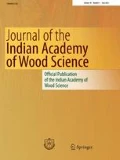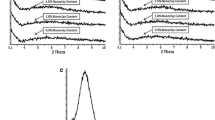Abstract
Impregnation with polymeric resin fortified with nanoparticles is one of the promising techniques to improve moisture-related behaviours, strength properties and thermal stability of low-density wood. Nanowood composites (NWC) were produced by impregnating the phenol formaldehyde (PF) resin fortified nanoclay (NC) nanoparticle in fast grown low density Melia dubia wood. Dried wood samples were impregnated with different concentrations of PF resin (10–30%) fortified with 0.5–3.0 wt% of NC using vacuum and pressure technique. Different physical and mechanical properties such as density, water uptake, shrinkage, flexural strength properties, compressive strength and surface hardness were evaluated. Decay resistance of NWC against brown and white rot fungi and thermal stability were determined and found to be enhanced. The amount of improvement in different properties of Melia dubia NWC was found to be dependent on concentration of nanoparticle-resin impregnated into the wood. Microscopic characterization of NWC using scanning electron microscope (SEM) showed that nanofiller and PF resin bulked the fibre lumen, penetrated the cell wall structures and also reacted with hydroxyl groups improving different wood properties to various extents. Thus, this processing technique may be employed to upgrade the quality of plantation grown lower density hardwoods. Preparation of such composites may represent a promising approach to obtain improved wood products for various value-added applications such as furniture, flooring, wall panelling and light construction.












Similar content being viewed by others
References
Akhtari M, Taghiyari HR, Ghorbani KM (2013) Effect of some metal nanoparticles on the spectroscopy analysis of Paulownia wood exposed to white-rot fungus. Eur J Wood Prod 71:281–283
Altgen M, Awais M, Altgen D, Kluppel A, Makela M, Rautkari L (2020) Distribution and curing reactions of melamine formaldehyde resin in cells of impregnation-modified wood. Nature Sci Rep 10:3366
Anon (1986) IS:1708, Indian Standard Specifications for ‘Methods of testing small clear specimens’ Bureau of Indian StandardsNew Delhi
Anon (2008) IS:4873, Indian standard specification for ‘Methods of laboratory testing of wood preservatives against fungi and borers (powder post beetles): Part 1- Determination of threshold values of wood preservatives against fungi’ Bureau of Indian Standards, New Delhi
ASTM (1999) D 1037–99, Standard test methods for evaluating properties of wood-base fiber and particle panel materials. American Society for Testing and Materials, West Conshohocken, PA (USA)
Cai X, Riedl B, Zhang SY, Wan H (2007) Formation and properties of nano composites made up form solid aspen wood, melamine-urea formaldehyde and clay. Holzforschung 61:148–154
Cai X, Zhang SY, Wan H (2008) The impact of the nature of nanofillers on the performance of wood polymer nano-composites. Compos A Appl Sci Manuf 39(5):727–737
Cai X, Riedl B, Wan H, Zhang SY (2010) Montmorillonite nanoparticle distribution and morphology in melamine-urea-formaldehyde resin-impregnated wood nanocomposites. Wood Fiber Sci 42(3):285–291
Clausen CA, Kartal SN, Arango RA, Green F III (2011) The role of particle size of particulate nano-zinc oxide wood preservatives on termite mortality and leach resistance. Nanoscale Res Lett 6:427
Deka M, Gindl W, Wimmer R, Christian H (2007) Chemical modification of Norway spruce (Picea abies (L) Karst) wood with melamine formaldehyde resin. Ind J Chem Technol 14:134–138
Devi RR, Maji TK (2012) Chemical modification of simul wood with styrene–acrylonitrile copolymer and organically modified nanoclay. Wood Sci Technol 46(1):299–315
Dungani D, Islam MN, Abdul Khalil HPS, Davoudpour Y, Rumidatul A (2014) Modification of the inner part of the oil palm trunk (OPT) with oil palm shell (OPS) nanoparticles and phenol formaldehyde (PF) resin: physical, mechanical, and thermal properties. Bio Resources 9(1):455–471
Freeman MH, McIntyre CR (2008) A comprehensive review of copper based wood preservatives with a focus on new micronized or dispersed copper systems. Forest Prod J 58(11):6–27
French AD (2014) Idealized powder diffraction patterns for cellulose polymorphs. Cellulose 21:885–896
Gao W, Guo C, Yi T, Zhao S, Du G (2018) Dynamic mechanical thermal analysis (DMTA) of aqueous phenol formaldehyde (PF) resin modified by nano copper oxide (CuO). Eur J Wood Prod 76(4):1145–1151
Gindl W, Gupta HS (2002) Cell-wall hardness and Young’s modulus of melamine-modified spruce wood by nano-indentation. Compos A Appl Sci Manuf 33(8):1141–1145
Gul W, Alrobei H, Shah SRA, Khan A (2020) Effect of iron oxide nanoparticles on the physical properties of medium density fiberboard. Polymers 12(12):2911
Gusse AC, Miller PD, Volk TJ (2006) White-rot fungi demonstrate first biodegradation of phenolic resin. Env Sci Technol 40(13):4196–4199
Hakamy A, Shaikh FUA, Low IM (2015) Characteristics of nanoclay and calcined nanoclay-cement nanocomposites. Compos B Eng 78:174–184
Hazarika A, Maji TK (2014) Properties of softwood polymer composites impregnated with nanoparticles and melamine formaldehyde furfuryl alcohol copolymer. Polym Eng Sci 54:1019–1029
Karimi A, Taghiyari HR, Fattahi A, Karimi S, Ebrahimi G, Tarmian A (2013) Effects of wollastonite nanofibers on biological durability of poplar wood (Populus nigra) against Trametes versicolor. BioResources 8(3):4134–4141
Kartal SN, Green F, Clausen CA (2009) Do the unique properties of nanometals affect leachability or efficacy against fungi and termites? Int Biodeterior Biodegrad 63:490–495
Kim HS, Kim S, Kim HJ, Yang HS (2006) Thermal properties of bio-flour-filled polyolefin composites with different compatibilizing agent type and content. Thermochim Acta 451:181–188
Kojima Y, Usuki A, Kawasumi M, Okada A, Kurauchi T, Kamigaito O (1993) Sorption of water in nylon6-clay hybrid. J Appl Polym Sci 49:1259–1264
Leemon NF, Ashaari Z, Uyup MKA, Bakar ES, Tahir PM, Saliman MAR, Ghani MA, Lee SH (2015) Characterisation of phenolic resin and nanoclay admixture and its effect on impreg wood. Wood Sci Technol 49:1209–1224
Lykidis C, Moya R, Tenorio C (2020) The effect of melamine formaldehyde impregnation and hot-pressing parameters on the density profile of densified poplar wood. Eur J Wood Prod 78(3):433–440
Mantanis G, Terzi E, Kartal SN, Papadouplos AN (2014) Evaluation of mold, decay and termite resistance of pine wood treated with zinc and copper based nanocompounds. Int Biodeterior Biodegrad 90:140–144
Papadopoulos AN, Bikiaris DN, Mitropoulos AC, Kyzas GZ (2019) Nanomaterials and chemical modifications for enhanced key wood properties: a review. Nanomaterials 9(4):607
Pavlidou S, Papaspyrides C (2008) A review on polymer-layered silicate nanocomposites. Prog Polym Sci 33:1119–1198
Qutubuddin S, Fu X, Tajuddin Y (2002) Synthesis of polystyrene-clay nano-composites via emulsion polymerization using a reactive surfactant. Polym Bull 48:143
Rahman MR, Hamdan S, Islam MS, Ahmed AS (2012) Influence of nanoclay/phenol formaldehyde resin on wood polymer nanocomposites. J Applied Sci 12(14):1481–1487
Rajput SS, Shukla NK, Gupta VK, Jain JD (1996) Timber Mechanics: Strength, Classification and Grading of Timber. 2nd edition, ICFRE-38, ICFRE, Dehradun, pp 189
Ray SS, Okamoto M (2003) Polymer/layered silicate nanocomposites: a review from preparation to processing. Prog Polym Sci 28:1539–1641
Sharma SK, Shukla SR, Sethy AK (2019) Comparative studies of important wood quality parameters of Melia dubia Cav of different age groups for finding suitability in various applications. J Ind Acad Wood Sci 16(1):44–50
Terzi E, Kartal SN, Yilgor N, Rautkari L, Yoshimura T (2016) Role of various nanoparticles in prevention of fungal decay, mold growth and termite attack in wood, and their effect on weathering properties and water repellency. Int Biodeterior Biodegrad 107:77–87
Uyup MKA, Khadiran T, Husain H, Salim S, Siam NA, Hua LS (2019) Resistance improvement of rubberwood treated with zinc oxide nanoparticles and phenolic resin against white-rot fungi Pycnoporus Sanguineus. Maderas-Cienc Tecnol 21(4):457–466
Wan H, Kim MG (2008) Distribution of phenol-formaldehyde resin in impregnated southern pine and effects on stabilization. Wood Fiber Sci 40(2):181–189
Wang X, Chai Y, Liu J (2013) Formation of highly hydrophobic wood surfaces using silica nanoparticles modified with long-chain alkylsilane. Holzforschung 67:667–672
Xu E, Zhang Y, Lin L (2020) Improvement of mechanical, hydrophobicity and thermal properties of Chinese fir wood by impregnation of nano silica sol. Polymers 12:1632
Yu W, Xie H (2012) A Review on nanofluids: preparation, stability mechanisms and applications. J Nanomater 2012:1–17
Zanatta P, Lzarotto M, De Gonzalez CPH, Da Silva CS, Moreira ML, Gatto DA (2017) The effect of titanium dioxide nanoparticles obtained by microwave-assisted hydrothermal method on the color and decay resistance of pinewood. Maderas-Cienc Tecnol 19(4):495–506
Acknowledgements
Authors are thankful the Director, IWST, Bangalore, for his keen interest in the research work. Technical support by Ms. N. Mamatha of Forest Protection Division, IWST, for pathological testing is appropriately acknowledged. The authors also thank the Centre of Nano Science and Engineering (CeNSE), Indian Institute of Science (IISc), Bengaluru, for using sample characterization techniques (SEM, XRD and FTIR).
Funding
This work was carried out under a research project titled “Value-addition of low-density woods by producing nanowood-composites (NWC) with enhanced properties for high end applications” funded by the Indian Council of Forestry Research and Education (ICFRE), Dehradun (India).
Author information
Authors and Affiliations
Corresponding author
Additional information
Publisher's Note
Springer Nature remains neutral with regard to jurisdictional claims in published maps and institutional affiliations.
Rights and permissions
About this article
Cite this article
Shukla, S.R., Sharma, S.K. Improving physico-mechanical properties, thermal stability and decay resistance of fast grown Melia dubia wood by nanoclay fortified phenolic resin impregnation. J Indian Acad Wood Sci 19, 1–15 (2022). https://doi.org/10.1007/s13196-022-00291-x
Received:
Accepted:
Published:
Issue Date:
DOI: https://doi.org/10.1007/s13196-022-00291-x




